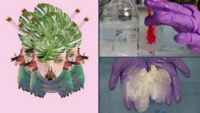Difference between revisions of "Mari mutare"
| (2 intermediate revisions by the same user not shown) | |||
| Line 1: | Line 1: | ||
| − | Work in progress <br> | + | Work in progress [http://www.hybridoa.org Mari mutare] <br> |
[[File:Mm8.png|200px|thumb|left|Mari mutare]] <br> | [[File:Mm8.png|200px|thumb|left|Mari mutare]] <br> | ||
Mari mutare is an experiment with biocompatible prosthesis inspired by the proto-Christian ornament of the Greenman: a pagan hybrid figure half-plant, half-human. Influenced by biohacking philosophy, feminist theory and speculative design methodology, this project examines the potentiality of biopractices (biomedia practices) as knowledge-making tools inn order to transcend human exceptionalism. <br> | Mari mutare is an experiment with biocompatible prosthesis inspired by the proto-Christian ornament of the Greenman: a pagan hybrid figure half-plant, half-human. Influenced by biohacking philosophy, feminist theory and speculative design methodology, this project examines the potentiality of biopractices (biomedia practices) as knowledge-making tools inn order to transcend human exceptionalism. <br> | ||
| + | |||
| + | The experimentation started between Utopiana Geneva, Hackuarium and [https://wetlab.hangar.org/tag/marimutare/ Wetlab @Hangar Barcelona ] | ||
This project is currently work-in-progress & supported by ProHelvetia, Hangar Barcelona (Biofriction EU program) and Utopiana Geneva in 2020.<br> | This project is currently work-in-progress & supported by ProHelvetia, Hangar Barcelona (Biofriction EU program) and Utopiana Geneva in 2020.<br> | ||
| Line 7: | Line 9: | ||
Protocol:<br> | Protocol:<br> | ||
| − | + | We want to decellularize plant leaves in order to get a vegetal scaffold. For this reason, we would need to wash away the chloroplasts. <br> | |
| + | 1.- We will submerge organic baby spinach leaves or any "fleshy" leaves such as Basilicum. etc, into a recipient with a 10%SDS solution of water* and a very strong detergent SDS. We can either soak them in bottles or Petri dishes, just keep in mind that the water will be discarded every 24hrs for 6 days. <br> ***ADvICE*** for a more ecological practice we will use glass Petri-dishes. We will soak them for 24hrs and discard the water** afterwards (around 15-20ml per Petri/leaf per day). Repeat the process for 6 days. | ||
| + | 2.- In the last 48 hours, we will immerse them in a different solution. We will create a 10% bleach solution with water We will soak them for 24hrs and discard the water afterwards (around 15-20ml per Petri/leaf per day). Repeat the process for 2 days. <br> | ||
| + | <br> | ||
| + | * I used distilled water at the begging, but is a haze when not easy access to it, so for non-medical purposes I would just use tap water. <br> | ||
| + | ** I use to wash them gently and thoroughly with my hands with gloves, THIS IS A VERY STRONG DETERGGENT THAT BREAKS OFF THE LIPIDS, INCLUDING THOSE IN YOUR HANDS. | ||
| + | *** This protocol is DIY-ed from the following scientific articles: 'Murphy et al. 2018' 'Murphy 2017' 'Fontana and Murphy 2017' '3-2020-plants bone adipose tendon Decellularized apple, carrot and celery-Altomare' '4-leaves fontana2017' 'Algae-Patch-eaba4311.full' . | ||
| + | <br> | ||
Latest revision as of 10:44, 14 June 2022
Work in progress Mari mutare
Mari mutare is an experiment with biocompatible prosthesis inspired by the proto-Christian ornament of the Greenman: a pagan hybrid figure half-plant, half-human. Influenced by biohacking philosophy, feminist theory and speculative design methodology, this project examines the potentiality of biopractices (biomedia practices) as knowledge-making tools inn order to transcend human exceptionalism.
The experimentation started between Utopiana Geneva, Hackuarium and Wetlab @Hangar Barcelona
This project is currently work-in-progress & supported by ProHelvetia, Hangar Barcelona (Biofriction EU program) and Utopiana Geneva in 2020.
Protocol:
We want to decellularize plant leaves in order to get a vegetal scaffold. For this reason, we would need to wash away the chloroplasts.
1.- We will submerge organic baby spinach leaves or any "fleshy" leaves such as Basilicum. etc, into a recipient with a 10%SDS solution of water* and a very strong detergent SDS. We can either soak them in bottles or Petri dishes, just keep in mind that the water will be discarded every 24hrs for 6 days.
***ADvICE*** for a more ecological practice we will use glass Petri-dishes. We will soak them for 24hrs and discard the water** afterwards (around 15-20ml per Petri/leaf per day). Repeat the process for 6 days.
2.- In the last 48 hours, we will immerse them in a different solution. We will create a 10% bleach solution with water We will soak them for 24hrs and discard the water afterwards (around 15-20ml per Petri/leaf per day). Repeat the process for 2 days.
- I used distilled water at the begging, but is a haze when not easy access to it, so for non-medical purposes I would just use tap water.
- I use to wash them gently and thoroughly with my hands with gloves, THIS IS A VERY STRONG DETERGGENT THAT BREAKS OFF THE LIPIDS, INCLUDING THOSE IN YOUR HANDS.
- This protocol is DIY-ed from the following scientific articles: 'Murphy et al. 2018' 'Murphy 2017' 'Fontana and Murphy 2017' '3-2020-plants bone adipose tendon Decellularized apple, carrot and celery-Altomare' '4-leaves fontana2017' 'Algae-Patch-eaba4311.full' .
- I use to wash them gently and thoroughly with my hands with gloves, THIS IS A VERY STRONG DETERGGENT THAT BREAKS OFF THE LIPIDS, INCLUDING THOSE IN YOUR HANDS.
